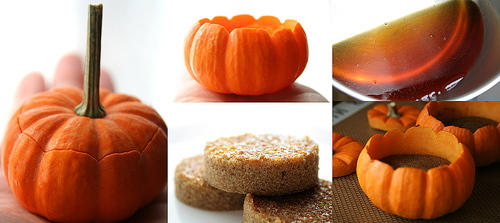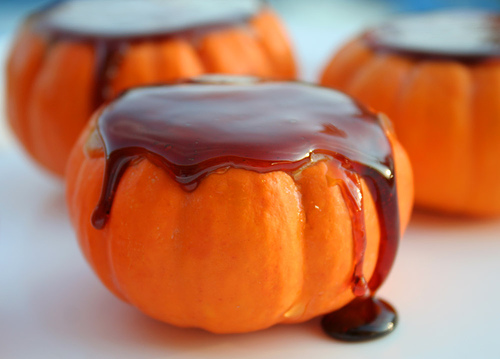-
Posts
2,351 -
Joined
-
Last visited
Content Type
Profiles
Forums
Store
Help Articles
Posts posted by Patrick S
-
-
Hi,
I started buying my chocolate for the Christmas "production" this weekend. I was also able to find some Hazelnut Praline Paste (Sevarome Ref: PFS.SK001.3048) - imported from France. It is a 1kg tin and ingredients are 50% roasted hazelnuts and 50% sugar - so far so good. I haven't been able to purchase praline paste before so brought it home and noticed a couple of warnings back in the apartment:
- Professional use only. Do not sale (sic) to the final consumer.
- Dosage g/kg = 120
I am not a professional chocolatier so I wanted to know why there were warnings and dosage levels. Praline paste seemed like a good thing to put on pancakes (as well as my planned chocolate applications) . . . but maybe not?!?!
Also, does the dosage mean a maximum of 120g of praline paste to 1kg of chocolate? What can happen if the limit is exceeded?
Thanks in advance for any help
I dont know how things are in France, but in the US food items have to be sold with certain labelling information. So, for instance, if you buy a large box of cupcakes or something, each one individual package will contain a disclaimer saying something like
Perhaps the warning on your jar of praline is the same thing. I doubt it has anything to do with the toxicological properties of praline paste."not labelled for individual sale."Maybe the dosage refers to a recommended concentration for the product in a recipe -- in other words, add the praline to the rest of the ingredients at a ratio of 12/100.
-
One question for Patrick: how did you achieve such a clean cut on these bars? I tried all sorts of knives but couldn't make anything but a rough and rustic edge.
I used a very thin, very sharp, very cheap chefs knife. I cut the bars up after they were well-chilled, and I wiped the blade clean between cuts.
-
I bought some fage greek yogurt the other day which was fat free. I put some honey in it and one small piece of pineapple. I threw it back in the fridge and ate it one day later and it tasted really bitter. what went wrong? I still ate it anyways, hopefully I won't die
My guesses --and these are just guesses -- is that 1) the honey provided more food for the Lactobacilli in the yogurt (these bacteria metabolize sugars), which then produced more lactic acid, or 2) that the pineapple enzymes denatured some of the milk proteins in the yogurt -- in some cases, enzymes can break down proteins which are not themselves bitter, into proteins fragments which do in fact taste bitter.
-
Uh-oh -- I think I've rambled on and not answered your question. Is this what you were thinking of?
Yes, that's exactly the kind of answer I was looking for. Thank you!
-
Actually, the smooth creamy texture of commercial peanut butters is more a product of the very fine particle size to which the peanuts are ground, and the emulsifiers that are added to it.
Regarding the presence of trans-fats in commercial peanut butter, the quantitites are so low as to be physiologically insignificant. According to the USDA's Agricultural Research Service:
Recurring rumors that commercial peanut butters contain trans fats--which appear to increase risk of cardiovascular disease--have no basis in fact, according to an Agricultural Research Service study.The rumors no doubt started because small amounts of hydrogenated vegetable oils are added to commercial peanut butters--at 1 to 2 percent of total weight--to prevent the peanut oil from separating out. And the hydrogenation process can generate the formation of trans fatty acids in oils, according to Timothy H. Sanders, who leads research at ARS’ Market Quality and Handling Research Unit at Raleigh, N.C.
To see if the rumors had any validity, Sanders prepared 11 brands of peanut butter, including major store brands and “natural” brands, for analysis by a commercial laboratory. He also sent paste freshly prepared from roasted peanuts for comparison. The laboratory found no detectable trans fats in any of the samples, with a detection limit of 0.01 percent of the sample weight.
That means that a 32-gram serving of any of the 11 brands could contain from zero to a little over three-thousandths (0.0032) of a gram of trans fats without being detected. While current regulations don’t require food labels to disclose trans fat levels, they do require disclosure of saturated fat levels at or above five-tenths (0.5) of a gram. For comparison, that’s 156 times higher than this study’s detection limit for trans fats.
In passing, it should also be noted that butter and cream contain natural trans-fat (created by microbial hydrogenation in vivo) in easily detectable quantities. As I recall, the contration of trans-fats in milkfat is around several percent -- orders of magnitude higher than the concentration in peanut butter.
-
Celery. Dill and fennel seeds.
-
The iced tea cookie is a linzer style dressed with glistening tea jelly accented with Southern Comfort. Blew my diet on these buggers today--lol!
Great job all around, K8, but I like the cookies the best!
-
I just made the thumbprints and while they taste great, I didn't make a large enough well for the jelly and the cookies don't work as nicely as they could. They are nutty, crumbly and would be perfect with a touch more fruit. I think they'd work really well with a hit of spice (ginger, lemongrass, cardamon, etc) in the cookie as well.
When I made these, I noticed that the wells started to puff back out as the cookies were baked. So about 2/3 of the way through baking, using a the oiled bottom of metal teaspoon, I gently tapped down the middle of the cookies, to reform the well. That allowed me to fit a lot more jam in the cookie than I would have been able to otherwise.
-
Actually I'm doing both. I'm using thanks giving as the applied piece of my senior project which has to do withy scince trends in food (ie molecular gastronomy) im doing six dishes, one oif which hot ice cream which i havent come up ith something to pair it with yet. but i want to caremlize cold ice cream to play with texture more and for more "shock" value. my current idea is to make scoops of maple ice cream and put themback into the freezer, then right befor ei carmelize them put them into a ziplock bag and cover with dry ice to "superfreeze" them so they will remain frozen after being subjected to molten sugar.
I'll be suprised if this works well -- hopefully only a small layer underneath will melt, but I can't imagine that you wont get a fair amount of melting. I do think that method will work much better than the blowtorch method.

If you had some hemisphere fleximolds, you could make little half-sphere shaped caramel "caps" which you could press onto the top of the scoops right before service.
Either way, please let us know how it works out!
-
Great... 18... when i called a welding shop about liquid nitrogen i was like im 17 and they hung up on me...
Psst . . . hey buddy, meet me behind the welding shop with your money, and I'll help you score some liquid nitrogen. . .
-
I doubt very much you could, as a commercial venture, use raw (i.e. unpasteurized) materials in baked goods.
You mean, you have to cook your eggs before using them as an ingredient in baked goods?

Federal law bans the interstate sale of unpasteurized milk. Some states ban the intrastate sale of unpasteurized milk, and some don't. However, if you are using milk as an ingredient in baked good, the ingredient is no longer sold "raw." In most cases I imagine the baked goods will achieve temperatures during baking that pasteurize the milk. So I wonder if the federal and state laws apply to use of raw milk as an ingredient in baked goods, or just to the sale of raw milk itself.
I thought about that. Since you're essentially pasteurizing the milk and eggs during cooking, what risk is there?
Essentially none, so far as I can tell.
But, also, what reward? Since you're cooking or baking with it, how much difference would it make in the end product?You'd have to direct that question to the raw milk advocates, since I am also unclear what the benefits would be.
Of course, there are numerous other environmental benefits, but how much would taste be affected?Well, I'm not sure what the environmental benefits of using raw milk would be, except perhaps that you are skipping one pasteurization, which would save energy. As to how taste would be affected, that's another question for raw milk advocates.
-
I doubt very much you could, as a commercial venture, use raw (i.e. unpasteurized) materials in baked goods.
You mean, you have to cook your eggs before using them as an ingredient in baked goods?

Federal law bans the interstate sale of unpasteurized milk. Some states ban the intrastate sale of unpasteurized milk, and some don't. However, if you are using milk as an ingredient in baked good, the ingredient is no longer sold "raw." In most cases I imagine the baked goods will achieve temperatures during baking that pasteurize the milk. So I wonder if the federal and state laws apply to use of raw milk as an ingredient in baked goods, or just to the sale of raw milk itself.
-
Hello, Dorie, and thanks so much for participating in this eGullet conversation! Having worked from your cookbooks for several years, and having such a good time doing so, its truly an honor to have you here.
I have a question that is closely related to some of those that have already been asked. One of the things that has struck me is the enormous influence and widespread adoption of French patisserie (and French cuisine in general) around the world. As an American who has spent a lot of time in France and worked with some great French chefs, do you have any thoughts, insights, generalizations or anecdotes you'd like to share as to why France seems to have had such a salient impact on the 'global culinary culture'?
-
Here's something I've been wanting to try for a while -- Sherry Yard's pumpkin creme brulee and gingerbread financier jack-o-lanterns. You hollow out tiny (3-4") pumpkins, put a gingerbread financier disc inside, glaze it with apple caramel glaze, fill with pumpkin creme brulee, and top with burnt sugar.
Is the custard cooked in the pumpkin? Those pumpkins don't look baked, whats the deal?
The custard is cooked in a 13x9 dish, and spooned into the pumpkins while still hot.
-
Looks incredible Patrick. How was it?
Thanks gfron! It was pretty good. Of the components, I like the gingerbread financier best.
Patrick, that's gorgeous! Do you use the pumpkin you hollowed out for the creme brulee?Thanks, Chihiran! I just used canned pumpkin.
Patrick, there's something about those little pumpkins, they're one of the best looking little desserts I've seen in a LONG time - Wow.That's so kind of you. Thanks!
-
Here's something I've been wanting to try for a while -- Sherry Yard's pumpkin creme brulee and gingerbread financier jack-o-lanterns. You hollow out tiny (3-4") pumpkins, put a gingerbread financier disc inside, glaze it with apple caramel glaze, fill with pumpkin creme brulee, and top with burnt sugar.


Flickr images:
-
Actually, the only commercial almond flour I use (Bob's Red Mill) doesn't seem all that fine, and I can definitely make finer almond flour at home using the food processor, just grinding, scraping down, grinding, scraping down. . . repeatedly.
-
Help! help! Help needed. I'm making the holiday bundt cake which calls for canned pumpkin. My febrile brain can't decide. Which measuring cup to use? I can see pro/con arguments each for liquid or volume measurement cups.
I debated about the same thing when I made this a couple of days ago. I settled on the measuring cups I use for dry ingredients & the cake was perfect.
pat w.
I would agree to use the dry measuring cups if you're not weighing, simply because you can scoop it in and level off the top, which you can't do with most liquid measuring cups.
-
Help! help! Help needed. I'm making the holiday bundt cake which calls for canned pumpkin. My febrile brain can't decide. Which measuring cup to use? I can see pro/con arguments each for liquid or volume measurement cups.
.
Yes, I know, it probably won't make a big difference either way. But this is just another instance where a weight measurement would resolve ambiguity.
1C pumpkin weighs 244 grams, so if you have scale, use that.
-
Also: do you think people who review cookbooks in newspapers have time to make dozens of recipes before they review the book?
No of course not, and that's one reason why I would find such reviews, based on a small number of trials, to be pretty much completely worthless from a cookbook-buyer's perspective. Especially if the cookbook in question has, say, hundreds of recipes. I mean, I'm still discovering recipes I love in cookbooks that I've had for 5 years, so, no, I would tend not to give much weight to reviews based on a couple of recipes tried over a couple of weeks. But that's just me, and other people are certainly entitled to make their own judgements however they see fit.
-
I think making 2 recipes and being underwhelmed is fine. I picked 2 very different recipes and did not find them special.
That's too bad, coconutlime. I hope you have better luck with any recipes you might try in the future. Personally, I have tried somewhere in the neighborhood of ten recipes from the book, and there was only one that I didnt care for (the tartest lemon tart), and several that I loved and will definitely make again (applesauce bars, vanilla pound cake and caramel peanut brownie cake, in particular).
-
Have you had any better luck with other recipes from the book?
I did make the brrrr-ownies and they were okay. A little sticky-chewy and hard to cut but fairly tasty. I am just surprised to hear of some much excitment over the book when I have been so underwhelmed. I wasn't even going to try another recipe but I had received the cookbook to review from the publishers and thought I owed it another try.
And you were going to do a review on the basis of trying two recipes?






Well, sure. Two recipes out of like 230 is a sufficient sample from which to make an overall judgement, right?
-
BTW -- when you guys made these, if you picked up a bar in your hand would it fall apart, or would you be able to eat it like that, or would you absolutely have to have a plate and a fork? IOW -- what should the texture be like? So a good 9x13 pan is next on my list I guess.
When I made them, they were indeed very soft and moist, but still sturdy enough to pick and and eat out of hand.
-
I had a quick question for you all, though - when I was scraping my vanilla beans, I got some weird, gelatinous stuff. It looked like clumps of bean scrapings, but it was like they were bound in goo. These clumps never really broke up or dissolved - I would up scooping as many of them out of the batter as I could. The cakes were fine - but had I not removed the clumps they likely would have appeared in the finished cakes. Does anyone know why this happened? Could my beans have been the problem? I'd never seen this before.
Welcome to eGullet, sugarsugar!
This may be a stupid question, but did you try whisking the clumps into the batter? I mean, when beans are exceptionally moist, and you split them and scape out the beans, the beans come out all stuck together in pea-sized clumps, and you have to use a whisk to break up the clumps and evenly distribute the beans in the batter.



Food left out overnight
in Cooking
Posted
The vast majority of bacteria will be killed at temperatures well below boiling, but boiling would pretty much insure sterilization. To illustrate, when milk is heated to 161.5F for 15 seconds, there is a 5-log reduction in micro-organisms in the milk (ie only 0.00001 of the microrganisms remain). However, even though the risk of bacterial infection is pretty much eliminated by boiling, some bacteria, like some types of Staphylococcus, can produce protein toxins which are themselves heat-stable and are not inactivated by boiling.